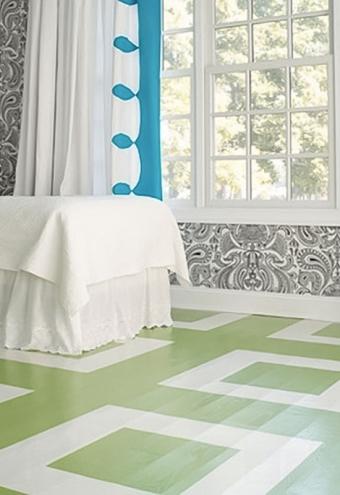Add Your Personality

Floors are not the part of the house that first comes to mind when thinking of possible painting projects. While the walls usually get all the attention for creative painting ideas, painting the floor is another way to jazz up your space, providing a unique -- and often unexpected -- ambiance to a room.
The most basic option is to paint over the existing floor with a single solid color, perhaps going from a drab brown or grey to a bright green, pink, or blue -- whatever suits your personality. Wooden floors can be covered with any durable interior paint but make sure to use a paint intended for concrete if you're working with that type of flooring. In any case, the floors will need a deep cleaning to remove dirt and grime. If the existing finish is shiny, sand it thoroughly or use a liquid deglosser to make sure the new paint will stick.
Bright and Bold Square Pattern

Moving beyond the monotone, there are a number of patterns with alternating colors that can be used to decorate the floor. The design in this slide simply requires applying masking tape to form the square pattern and then painting the green, resulting in crisp lines between the two colors. The original floor color could be left as one of the two colors, or a second new color could be added by inverting the position of the masking tape after the first coat has thoroughly dried.
Simple and Subtle

If bold colors aren't your thing, you can still use a patterned design, just stick with subtle variations of single, neutral colors, like the two shades of white in this example. The results are enchanting and elegant. The checkerboard pattern is a classic choice.
Checkerboard

Of all patterns, the checkerboard is probably the most straightforward to achieve and the least likely to call attention to itself. It is especially appropriate in a kitchen, where it mimics the traditional look of some tile and linoleum designs. Angling the checkerboard pattern on a diagonal gives a sense of dynamic energy and spaciousness in the room.
A Checkered Alternative

For something a bit more modern and avant-garde, shake up the checkerboard concept with a variation on the traditional theme. Each of the square spaces doesn't have to be filled with a square block of color. Consider alternating squares with other polygons, circles, or abstract shapes.
Stenciling Floors

Another popular approach to floor painting is to use stencils. There are many options available from paint suppliers and even art supply stores that can be used. You can also make your own with cardboard or mat board. Paint in your stenciled design on the existing floor or coat the existing floor with fresh paint first and then add the stenciling.
Stamping Floors

The inverse of stenciling is stamping, which is a better approach when you want to repeat the design many times to densely cover the entire floor area, rather than just here and there. Stamping usually involves putting the paint on a block of rubber cut in the desired design and pressing it onto the floor to make a print. There are other techniques that create a more textured finish, however, such as applying the paint with a sponge.
Playing With Patterns

There is no limit to the options for patterning on a painted floor. You may want to do a combination of straight line patterns made with masking tape, stamping and stenciling to produce a desired effect. To find ideas for patterns, look to other objects for inspiration -- paving patterns, for example, or abstract patterns, like wood grain or clouds. This example is reminiscent of a weaving or knitting pattern.
A Painted Rug

One common approach is to implement your floor painting pattern as if it was rug positioned in the middle of the floor space. This is one way to make a really wild floor painting design look like it fits right in. People are used to very ornate rug designs on the floor, but the same visual effect can be achieved with paint - which is usually much less expensive and easier to maintain than a rug!
Sign up for our newsletter featuring all the latest stories and products we love.
Borders

The inverse of a rug pattern would be a border at the edge of the floor. This is an elegant way to frame your floor painting project, or it can be added without painting the rest of the floor, but simply as a way to spruce up the existing floor.
Combine Paint With Stain

There is no need to paint the floor in its entirety. Often paint can just be one component of the floor design, such as this example in which paint is combined with wood stain. Most of the floor is covered in a semi-transparent stain (the large dark squares) while the dark brown paint is used to set off the remaining strips of lighter wood.
Specialty Textured Options

The possibilities for the texture of the paint are as endless as those for the pattern in which they are applied. For example, a terra cotta look can be created by swirling various earth tones with a bit of white paint and brushing or stamping it on. In this case, don't thoroughly mix the colors, just swirl them gently. Experiment with adding a bit of sand, stamping with different materials and adding multiple coats with different ingredients to get a unique look.
Painting the floor is an often overlooked component of interior design. Compared to other floor refinishing approaches, painting an existing wood floor or existing concrete floor is an inexpensive way to spruce of the space.







